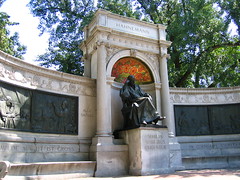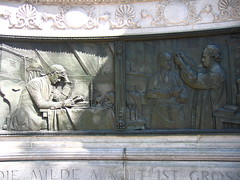
Dr. Samuel Hahnemann courtesy Flickr user kimberlyfaye
On the East side of Scott Circle at Massachusetts Ave. and Rhode Island Ave. NW, there’s a wide concrete and bronze monument to German physician Dr. Samuel Hahnemann. What an odd thing to memorialize in the capital of the United States, I thought. I vaguely recognized the name because of a high school friend who had been accepted to a medical school named for Dr. Hahnemann, but that was the extent of my knowledge. But as in all things, the Internet knows all.
Dr. Hahnemann is best remembered for inventing the field of homeopathy, the underlying principle of which is that “like cures like.” After conducting some tests on himself with cinchona bark (which contains quinine) and noticing that the anti-malarial treatment actually produced malaria-like symptom, he reached a conclusion. Hahnemann believed that a substance which could produce a certain kind of symptoms in a healthy person could cure those symptoms in a sick person, when given in amounts small enough to not generate those symptoms.

photo by Tiffany BridgeThat may not sound all that rational to those of us accustomed to antibiotics and modern painkillers, but it’s worth pointing out that in the late 18th and early 19th century when Hahnemann lived, Louis Pasteur hadn’t yet discovered microbes, and Edward Jenner had only recently discovered vaccination, which consists of giving a healthy person a weakened form of the disease you’re trying to prevent. In that context, Hahnemann’s theory seems perfectly reasonable.
And indeed, homeopathy gained acceptance because homeopathic doctors were getting better results than their traditional counterparts, and patients started demanding homeopathic treatment. As non-homeopathic treatments started improving, homeopathy fell out of favor, but is experiencing a resurgence as people become more interested in alternative medicine and natural products.

photo by Tiffany BridgeIn addition to his work in the field of homeopathy, Hahnemann recognized hygiene as a key factor in the control of disease, particularly cholera, and advocated for bed rest, fresh air, and isolation of infected patients at a time when other doctors considered those things to be ineffective. And now, what’s the first thing we do when someone gets sick? We yell at them to go to bed and keep their germs away from us.
The monument itself, by C.H. Niehaus, was installed in June 1900 as a gift from the American Institute of Homeopathy. It has a brilliant mosaic in the half-dome just above Hahnemann’s head which catches the light, which is a pretty unique feature in this city of bronze statues and marble pillars. On the pedestal on which the Hahnemann statue sits is an inscription: “similia similibus curantur,” or “like cures like.” There are arced panels on either side of the central figure, containing bronze reliefs of scenes from Hahnemann’s career. The panels back concrete benches, making the monument a pleasant place to sit and rest on a walk through the city.
Monumental is a bi-weekly feature covering the various monuments and decorations of Washington DC. If you’d like to suggest a monument for exploration, please email tom at welovedc dot com.











